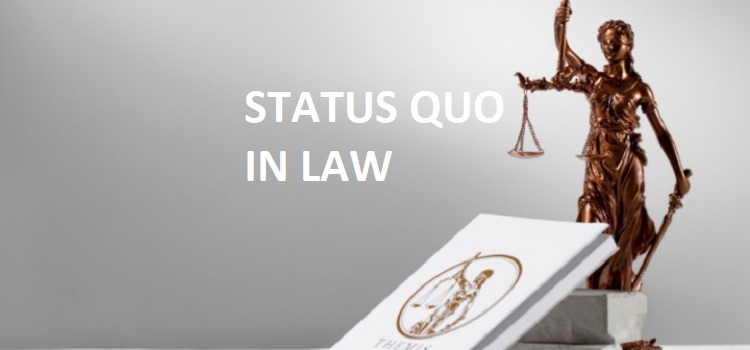Status Quo Meaning: How It Forms Lawful Decisions and Criteria
Navigating the Characteristics of Status in Legal Solutions: An All Natural Approach
In the world of legal systems, the idea of standing quo holds a considerable duty in shaping the structure upon which regulations and laws are built. By delving right into the detailed interplay of numerous variables affecting the legal standing quo, one can discover nuanced insights that lead the method for educated decision-making and critical preparation.
The Importance of Standing Quo Analysis
In legal process, carrying out a complete standing quo evaluation is vital to comprehending the present state of affairs and providing a foundation for notified decision-making. This evaluation includes an extensive review of existing problems, arrangements, and circumstances that shape the context within which lawsuits are being thought about. By examining the status, lawyers can recognize essential stakeholders, legal rights and responsibilities, possible threats, and possibilities for resolution.
In addition, diving right into the standing quo assists in the recognition of any type of spaces or variances that may exist, clarifying areas that require attention or clarification. This procedure help in establishing reasonable expectations and developing strategies that align with the prevailing circumstances. Recognizing the standing quo is critical for creating a roadmap that overviews legal proceedings in the direction of efficient outcomes while reducing unplanned repercussions.
Inevitably, a precise condition quo analysis acts as a foundation for audio lawful guidance and tactical preparation. It allows legal practitioners to browse complexities, prepare for difficulties, and tailor their strategy to accomplish favorable outcomes for their clients.
Factors Affecting Lawful Status
Taking into consideration the detailed internet of laws, regulations, and societal standards, what are the main factors that form and affect the legal standing quo in modern legal systems? Numerous essential factors play essential duties in establishing the lawful status quo within a lawful system. Furthermore, political characteristics and the balance of power within a lawful system can greatly influence the lawful condition quo.
Methods for Status Management
Reliable administration of the legal standing quo requires a strategic technique that acknowledges the vibrant nature of legal systems and the varied factors influencing them. One key method for status administration is regular tracking and evaluation of legal growths. This involves staying upgraded on new legislations, laws, and judicial decisions that might influence the current lawful landscape. By proactively keeping track of these adjustments, legal experts can prepare for potential difficulties and adjust their approaches accordingly.

Furthermore, efficient interaction and partnership amongst stakeholders are vital approaches for handling the standing quo in legal systems. By promoting open dialogue and cooperation between policymakers, lawyers, click here for info and various other pertinent parties, potential disputes can be dealt with proactively, and solutions can be established collaboratively to keep a stable legal atmosphere.
Obstacles in Status Adaptation

Additionally, the absence of clear guidelines for browsing status quo modifications can develop uncertainty and uncertainty. Lawyers usually find themselves in undiscovered region when attempting to challenge existing standards or incorporate new lawful structures. This can bring about hesitancy try this and hesitation to differ familiar methods, even more hindering the adjustment procedure.

Executing Holistic Techniques
Integrating a comprehensive point of view into lawful approaches is crucial for attending to the multifaceted obstacles of contemporary lawful systems. Executing all natural methods entails a shift towards watching legal problems as interconnected components of a bigger system instead of separated cases. This requires a positive position that considers not only the prompt legal ramifications yet additionally the broader societal, economic, and honest influences of legal decisions.
One secret facet of implementing holistic methods is promoting interdisciplinary cooperation within lawful teams. By combining experts with varied histories such as law, psychology, economics, and sociology, a much more nuanced understanding of complicated lawful concerns can be attained. This collaborative technique allows lawful professionals to create a lot more effective approaches that account for a vast array of elements influencing the end results of lawful instances.
Moreover, welcoming innovation and data-driven insights is critical in implementing alternative techniques in legal systems. Leveraging tools like expert system for legal study, anticipating analytics for instance outcomes, and information visualization for providing intricate details can improve decision-making processes and boost general lawful end results. By integrating these technological developments right into legal practice, a more effective and holistic technique to attending to lawful obstacles can be attained.
Verdict
Finally, navigating the dynamics of status in lawful systems requires an extensive understanding of the importance of status quo analysis, the various factors influencing lawful standing quo, effective methods for condition quo monitoring, and the difficulties in status adjustment. Applying alternative techniques is important for successfully adjusting and Find Out More handling to the status in lawful systems. It is essential for legal experts to frequently evaluate and adapt to the transforming characteristics of the status quo to ensure effective and reliable legal end results.
Thinking about the complex web of laws, laws, and social standards, what are the primary factors that shape and influence the lawful condition quo in modern lawful systems? A number of crucial elements play critical functions in establishing the lawful standing quo within a lawful system. It is the interaction of these aspects that collectively form and affect the lawful condition quo in modern legal systems.
Reliable administration of the lawful status quo needs a calculated method that recognizes the dynamic nature of lawful systems and the varied aspects influencing them.In conclusion, browsing the characteristics of standing quo in lawful systems requires a detailed understanding of the importance of condition quo analysis, the numerous aspects affecting legal condition quo, efficient techniques for status quo monitoring, and the obstacles in condition quo adjustment.